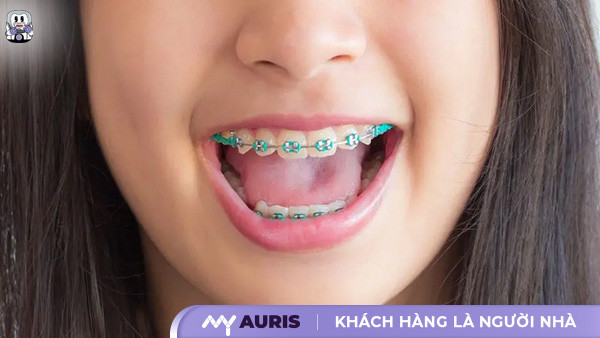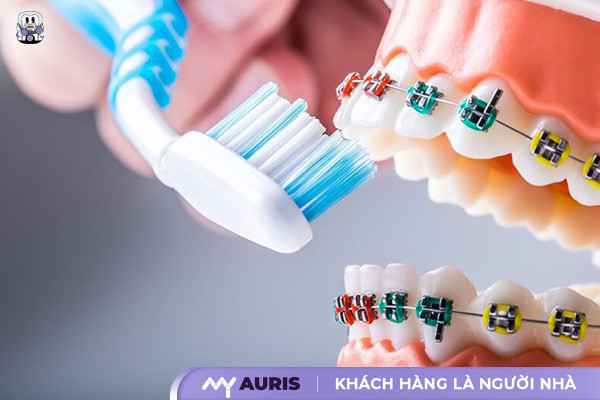Parents often wonder whether they should get braces for their children. To make a decision, parents need to recognize the signs that their child needs orthodontic treatment. This article, with expertise from My Auris Dental Clinic, will provide a clear roadmap, laying the foundation for a beautiful, aligned set of teeth.
Should a 6-year-old get braces?
This question is a concern for many parents. The age of 6 is a special time. This is when children begin the process of tooth replacement, with both primary (baby) teeth and permanent teeth coexisting. Orthodontic intervention at this stage is not like adult braces. It is called preventive orthodontics or early interceptive orthodontics. The primary goal is not to immediately achieve perfectly aligned teeth. The goal is to create a solid foundation for the development of the jawbone and to guide the permanent teeth to erupt into their correct positions later on.
This golden age for braces offers significant benefits. The jawbone of a 6-year-old is still soft and undergoing rapid development. An orthodontist can utilize this natural growth to align teeth and guide jaw development. Early intervention helps address problems at their root. For example, it can widen a narrow dental arch, prevent bad habits such as thumb-sucking or tongue thrusting, or treat an underbite. If left unaddressed, these issues can lead to more severe misalignments in the future, making subsequent treatment more complex and costly. This also helps create enough space for permanent tooth buds to erupt in the correct positions, minimizing the likelihood of needing tooth extractions later.
However, the decision to get braces for a 6-year-old needs careful consideration. Not every child requires early intervention. The decision depends on the specific oral condition, type of bite, and degree of misalignment.

9 Signs a 6-Year-Old Needs Early Orthodontic Treatment
Crowded, crooked teeth: This is the most easily noticeable sign. Newly erupted permanent teeth do not have enough space in the dental arch, forcing them to rotate, tilt, or overlap each other. The underlying cause is that the jawbone size is smaller than the tooth size, leading to a lack of space.
Spaced teeth, large gaps: Contrary to crowding, the child’s teeth erupt far apart, creating large gaps. This condition can be due to teeth being small relative to the dental arch or due to bad habits like tongue thrusting.
Overjet (Class 2 Malocclusion): When the child closes their mouth normally, observe from the side. If parents notice that the upper jaw and the upper front teeth protrude too much compared to the lower jaw, that is a sign of an overjet.
Underbite (Crossbite): This sign is the opposite of an overjet. When the child closes their mouth, the lower front teeth are positioned in front of the upper front teeth. An underbite is one of the misalignments that require the earliest intervention to avoid negatively affecting jawbone development.
Crossbite: Ask the child to bite their teeth together. Observe if any group of upper teeth falls inside the group of lower teeth, instead of overlapping outside as normal. A crossbite can cause tooth wear and facial asymmetry if left untreated.
Open bite: When the child bites their teeth tightly, if there is a gap between the upper and lower front teeth such that the child cannot bite through a thread, that is an open bite. Habits such as thumb-sucking, tongue thrusting, or mouth breathing are common causes of this condition.
Difficulty chewing or speaking: Pay attention to whether the child has difficulty biting or tearing food. Some bite misalignments can affect how the child pronounces certain sounds, leading to speech impediments.
Persistent bad habits: Habits such as thumb-sucking, tongue thrusting when swallowing, or mouth breathing instead of nasal breathing after age 5 are all factors that cause dental and jaw misalignments. If these habits are not eliminated, orthodontic treatment later on will be more challenging.
Facial asymmetry: Look straight at the child’s face and notice if the line connecting the two jaws is straight and symmetrical. Severe bite discrepancies can lead to uneven development of the jawbones, making the face appear asymmetrical.
Types of Braces for 6-Year-Old Children
Choosing the appropriate method for a 6-year-old depends entirely on the dental condition and the orthodontist’s diagnosis. Parents need to understand the nature of each type of appliance to collaborate effectively with the dentist on the journey to give their child beautiful, aligned teeth and a proper bite. Currently, there are two main categories of methods applied to children in this age range for orthodontics.

Removable Orthodontic Appliances
This is the most common choice for children during the primary dentition phase and the beginning of tooth replacement. Removable appliances are devices that children can take out themselves for eating, cleaning, and then reinsert according to the dentist’s instructions. They work on the principle of creating gentle force to act upon and promote jawbone development.
Main purposes of removable appliances:
Widen the dental arch: Create enough space for unerupted permanent teeth to erupt in a straight line, avoiding crowding.
Correct skeletal misalignments: Early intervention for conditions such as underbite (Class III malocclusion) or deep bite.
Eliminate bad habits: Support the treatment of habits such as thumb-sucking, tongue thrusting, mouth breathing—habits that directly affect craniofacial development.
Common types of removable appliances:
Palatal Expander: Used to widen a narrow upper jaw.
Twin Block appliance: Used to adjust lower jaw development, effective for cases of a recessed lower jaw.
Headgear/Face Mask appliance: Used to correct anterior-posterior skeletal discrepancies.
Pros and cons parents need to know:
- Pros:
Easy to clean: Children can remove it to brush their teeth as usual, which helps prevent cavities more effectively.
Comfortable eating: No need to avoid too many types of food.
Aesthetics: Children only need to wear it at specific times of the day as prescribed, usually in the evening and at home.
- Cons:
Dependent on cooperation: Treatment effectiveness relies heavily on the child’s self-awareness and cooperation. Close parental supervision is required.
Easy to lose: Since it is removable, children might misplace the appliance.
Treatment duration can be flexible but requires strict adherence to the daily wearing hours.

Fixed Braces
Fixed braces at ages 6-7 are typically not applied to the entire dentition. Instead, dentists use a method called 2×4 braces. This technique involves attaching brackets only to the 4 upper permanent front teeth and the 2 erupted permanent molars (tooth #6).
Main purposes of 2×4 fixed braces:
Aligning front teeth: Correcting crowded, protruding, or rotated front teeth right from their eruption.
Treating anterior crossbite: Quickly addressing situations where the lower front teeth overlap the upper front teeth.
Creating space: Helping to move teeth to create space for other teeth to erupt.
Types of brackets that can be used:
Metal braces: Common, durable, effective, and cost-effective.
Ceramic braces: Tooth-colored, offering better aesthetics but at a higher cost and being more prone to breakage.
Pros and cons for parents to consider:
- Pros:
High effectiveness: Continuous 24/7 force helps teeth alignment occur quickly and precisely.
No dependency on cooperation: Since the appliance is fixed, parents don’t need to worry about their child forgetting to wear it.
- Cons:
Difficult to clean: Food can easily get stuck in the brackets, requiring children to be thoroughly instructed on proper dental hygiene.
Initial discomfort: Children may feel an unfamiliar sensation or slight bulkiness during the first few days.
Child’s diet: Hard, chewy, and sticky foods should be limited to prevent brackets from detaching.

What Parents Need to Prepare for Smooth Braces Treatment for 6-7-Year-Olds?
The decision to get braces for a 6-year-old is a significant investment in the child’s future. This is not just about finances but also an investment of time, effort, and the family’s psychology. Many parents are concerned about this process. Below are 5 core steps that every parent needs to take.
Choosing a Reputable Dental Clinic
Choosing the right place to entrust your child’s dental and maxillofacial health is a foundational step that determines 90% of the success. This is an important medical decision, directly affecting children’s health and the aesthetic outcome of their teeth later on. A reputable dental clinic not only ensures professional expertise but also provides peace of mind for the entire family.
Preparing the Child Psychologically
The journey of getting braces is not just for parents but also for the child themselves. The child’s ability to cooperate is a crucial factor. Thorough psychological preparation will help the child embrace the treatment gently, even with excitement. The goal is to turn the brackets or orthodontic appliances into companions for the child on their path to having healthy, beautiful teeth.
Step 1: Talk openly and positively. Discuss braces with your child early on. Use simple, positive language. Instead of saying they “have to wear” braces, say they will soon have “little friends” to help their teeth line up neatly. Absolutely avoid negative words like painful, uncomfortable, or ugly.
Step 2: Use visual aids. Children learn best through images. Parents should find pictures and videos of other children wearing braces and having fun. This helps normalize the process in the child’s mind.
Step 3: Give the child a sense of control. Participation helps children feel like they are part of the decision. If the child wears fixed braces, let them choose their favorite elastic band color at each follow-up appointment.
Step 4: Set realistic expectations. Be gently honest. Explain to the child that for the first few days, their mouth might feel strange or a little bulky, like wearing new shoes. Emphasize that this feeling will quickly pass and that parents will always be there to help.
Establishing an Appropriate Diet
Prioritize soft, easy-to-chew foods. During the first week after appliance placement and after each adjustment, the child’s gums and teeth will be more sensitive. Parents should prepare soft foods that do not require much chewing force.
Recommended foods: Porridge, soup, broth, yogurt, soft cheese, eggs, steamed fish, minced meat, soft-boiled vegetables, mashed potatoes, smoothies.
Identify and eliminate risky foods. Some foods are enemies of braces. Parents need to clearly explain this to their child and remove them from the daily menu.
Foods to avoid:
Hard foods: Nuts, hard candy, ice cubes, bones, cartilage, popcorn. These can cause brackets to detach or break, or bend the archwire.
Chewy foods: Gummy candies, chewy bread, beef jerky. They easily get stuck in brackets and are difficult to clean, increasing the risk of failed cavity prevention.
Sticky foods: Caramel candy, chewing gum. They adhere tightly to the appliance and are very difficult to clean.
Change eating habits: Instead of biting and chewing directly, parents should teach their child a new eating technique. Cut everything, from fruits like apples and pears to bread and meat, into small, bite-sized pieces. Guide the child to chew gently using the back teeth instead of using the front teeth to bite. This helps protect the bracket system at the front and minimizes unwanted incidents.

Guiding Your Child on Proper Oral Hygiene
Caring for braced teeth requires more than just a regular toothbrush. Parents should prepare a complete kit for their child:
Soft-bristled toothbrush: Choose a toothbrush with a small head to easily maneuver around the brackets.
Interdental brush: This is an essential tool for cleaning the areas between brackets and under the archwire, where a regular toothbrush often cannot reach.
Orthodontic floss (Superfloss) or water flosser: A water flosser is particularly effective and easy for young children to use. It uses a high-pressure stream of water to gently dislodge trapped food particles.
Fluoride mouthwash: Helps strengthen tooth enamel and aids in cavity prevention.
Step-by-step brushing technique:
- Brush the outer surfaces: Position the toothbrush at a 45-degree angle to the gumline. Gently brush above the brackets, then brush below the brackets.
- Brush each bracket: Use the tip of the toothbrush to gently circle around each bracket.
- Brush the inner and chewing surfaces: Brush these surfaces as usual, ensuring no area is missed.
- Use an interdental brush: Thread the interdental brush under the archwire and move it back and forth to clean between teeth. This process should occur after every meal and before bedtime, lasting at least 3-4 minutes each time.
Attending Follow-up Appointments on Schedule
Adhering to follow-up appointments on schedule is a disciplinary factor that ensures the braces treatment progresses correctly and achieves optimal results. Each appointment with the orthodontist has a specific purpose within the overall treatment plan. Missing an appointment can delay the process by several weeks or even months.
Questions to Consider When Getting Braces for Children
Is getting braces for a 6-year-old painful or dangerous?
The sensation a child might experience is not a sharp pain. It’s a feeling of tightness or mild soreness in the teeth. This is because the orthodontic appliance applies a gentle, continuous force to align the teeth and jawbone into their correct positions. This sensation is usually most noticeable during the first 2-4 days after the appliance is placed or after each follow-up appointment for adjustments. This feeling will gradually subside as the mouth and teeth become accustomed to the change.
Getting braces for a 6-year-old is a safe medical procedure. Any potential dangers arise from choosing the wrong dental facility or an inexperienced dentist. A skilled orthodontist will manage all risks. Therefore, the most crucial step to ensure absolute safety is to choose a dental clinic specializing in pediatric dentistry and orthodontics.
Will getting braces for a 6-year-old harm their teeth?
The answer is no. When performed correctly, braces at this age do not cause harm; instead, they are a protective measure, creating the best conditions for the child’s long-term oral health.
The primary goal of interceptive orthodontics at this stage is not to immediately achieve perfectly aligned teeth. The goal is to correct skeletal discrepancies. For example, widening a narrow dental arch to create enough space for permanent teeth to erupt, or correcting an underbite. Conversely, failing to intervene early with these misalignments is precisely the source of future problems. A malocclusion can lead to tooth wear, temporomandibular joint (TMJ) disorders, and difficulties with chewing and speech.
Can a child get braces when they start losing baby teeth?
The answer is absolutely yes, and this is often considered the golden window to begin interceptive orthodontics. The stage from 6 to 10 years old, when children are transitioning from primary teeth to permanent teeth, is a valuable window of opportunity for tooth alignment.





